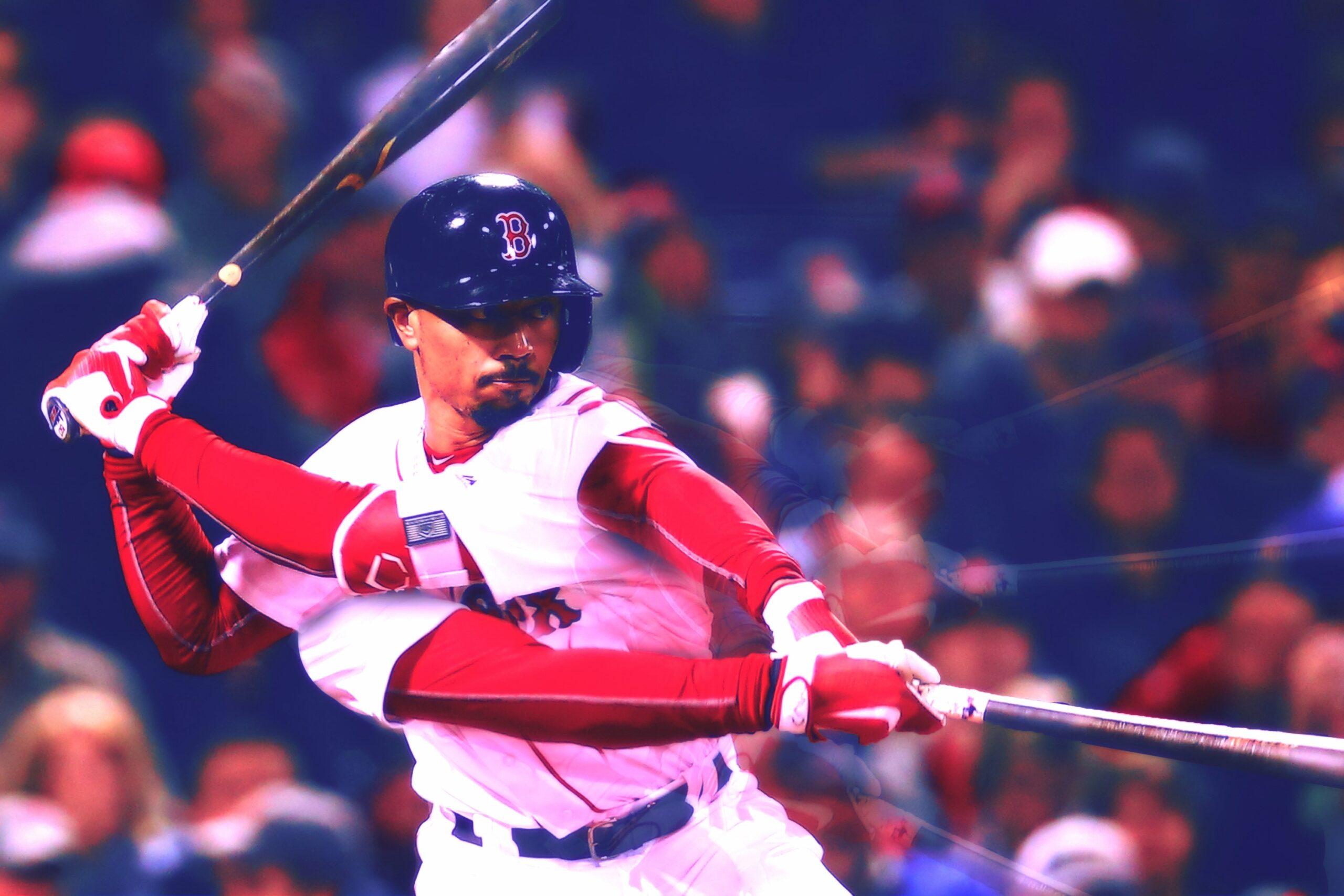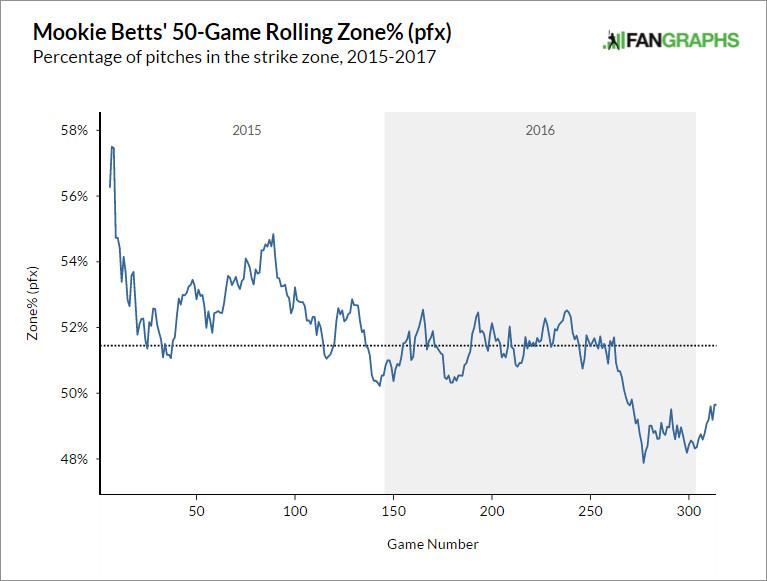
With Blue Jays reliever Danny Barnes’s team trailing the Red Sox 8–4 with two outs in the top of the eighth inning Tuesday night, the righty trotted in to take on Mookie Betts, last year’s runner-up in the AL MVP race. As runners led off second and third, Barnes started Betts with two fastballs that Betts took for called strikes, then fired a third that sailed high for a ball. With one strike separating him from the end of the inning, Barnes went with another four-seamer, this time over the inside part of the plate. Betts swung under it, popping out to catcher Russell Martin. The Red Sox’s threat was over.
So was the threat to Betts’s streak of not striking out, which the popout lengthened to 128 plate appearances. Betts last struck out in his final trip to the plate on September 12 of last season (not including his first postseason plate appearance, in which he went down swinging — and which, by baseball’s record-keeping convention, doesn’t count). Since then, 46 hitters have struck out at least 30 times, led by Byron Buxton with 49. No other active strikeout-less streak comes close to Betts’s; the Reds’ José Peraza is second at 47 plate appearances.
Betts has belittled the streak, calling it "pretty irrelevant" after Tuesday’s game. "An out’s an out. I don’t care about that at all," he added.
But despite Betts’s attempts to downplay its significance, the streak has attracted attention. It’s too anachronistic not to. Granted, Betts is less than 60 percent of the way to the expansion era record of 223, set by Dave Cash in 1976. But Betts is the first hitter to reach 100 strikeout-free plate appearances since Jeff Keppinger in 2010, and his strikeout-less streak is the longest since Juan Pierre went 147 PA without whiffing in 2004.
Baseball’s offensive environment is dramatically different from what it was during Pierre’s streak. American League non-pitchers have struck out in 21.5 percent of their plate appearances thus far this season, on track for a 10th consecutive season with a strikeout-rate increase. National League non-pitchers (a cohort that included Pierre) struck out in only 16.3 percent of their plate appearances in 2004, when the average fastball velocity (according to BIS data) was 2.5 mph slower. It’s much harder today to do what Betts is doing.
As Red Sox manager John Farrell has said, Betts’s streak is a testament to the elite, bowling-honed hand-eye coordination, reaction time, and pitch-recognition skills that helped make him so appealing as an amateur player.
"At first look, some people might say, ‘Well, he’s making contact early in the count and just looking to put the ball in play,’" Farrell told The Boston Globe’s Julian Benbow. "But there’s been production, there’s been damage from extra-base capabilities over the span of those at-bats, there’s been deep counts, there’s been walks."
Farrell is right on most of those scores, but not all of them. Betts’s streak is a great source of fun facts, but the 24-year-old is right to pooh-pooh it from a performance perspective. As amazing as this span of strikeout-free plate appearances is — and as much as we might fixate on Betts’s status as a statistical outlier — it won’t be a bad thing for Boston when someone finally snaps the streak. Like a lot of hitters, Betts is probably better when he is striking out.
Consider the difference in Betts’s offensive output during his strikeout-less streak and during a span of the same number of plate appearances that ended the day before the streak started.

During the earlier span, Betts struck out 13 times. But he also pulled balls more often and hit them harder and higher, launching seven home runs compared with the two he’s hit during the strikeout-less streak. His isolated power — batting average subtracted from slugging percentage, a measure of extra-base-hit production — was more than twice as high over the preceding span.
Farrell’s assertions were largely accurate: Betts has remained productive at the plate during his strikeout-less streak, and he’s walked more often. (This season, he’s triple-slashing .356/.420/.489 in 50 plate appearances.) But the "damage from extra-base capabilities" has been lacking, relative to Betts’s previous performance. That’s understandable, since it’s very difficult to record such a low strikeout rate while also hitting for power. The three aforementioned non-strikeout streakers — Cash, Pierre, and Keppinger — posted low-to-modest ISOs during their streak seasons, with their ISOs in those years (.062, .081, and .105, respectively) descending in the same order as the length of their streaks.
If we assume that Betts’s innate strikeout rate is similar to what his career major league rate was when the streak started (12.7 percent), the probability that he could go K-less for this long by chance alone is 0.00000003, or about one in 33 million. Strikeout rate quickly reflects players’ true talent, so it’s likely that Betts has had a different strikeout skill level during the streak. However, there’s no obvious sign that Betts’s strikeout avoidance and relative power outage have stemmed from an intention to make more contact. "He hasn’t done anything [new] from an approach standpoint," the Globe’s Alex Speier tells me via direct message. "He doesn’t seem to be trying to trade [power for contact], at least based on what he’s said to me."
Instead, it seems as if Betts’s reduced power production has stemmed from two factors: health and a change in his opponents’ approach. Beginning last July, Betts dealt with soreness in his right knee that led to arthroscopic knee surgery in November to remove damaged tissue and a loose body. Although he played through the injury and hit well throughout much of the second half, the knee injury may have affected his ability to drive balls toward the tail end of the season. With the joint repaired, Betts then succumbed to the flu at the outset of this season, a victim of the epidemic that swept the Red Sox clubhouse. Betts missed four games after Opening Day, and although he returned to the lineup April 9, his illness may have left him somewhat weakened.
Even when Boston’s bugs and his own body weren’t conspiring against Betts, opposing pitchers were. Probably because of his less-than-imposing height and build, Betts’s opponents continued to pitch him as if he wasn’t a serious power threat long after his stats suggested he was. Pitchers kept pounding the strike zone, and Betts kept using his strong wrists to punish them for underestimating his skills.
Late last season, though, pitchers appeared to get the memo, and the rate of pitches inside the strike zone that Betts was seeing sank. He also saw slightly more breaking balls and off-speed stuff in the second half. With pitchers treating him less like a pushover, Betts’s task got tougher.

Not only do those developments help explain Betts’s small-sample power problems, but they also burnish his strikeout-less streak: The kind of contact he’s shown lately looks even more impressive when we know that he’s been hobbled and/or trying to counter a large league adjustment.
We don’t yet know for certain whether age, experience, and strength will allow Betts to counter pitchers’ adjustments and equal or surpass the 31 homers and .216 ISO he finished with last season. But we have seen strong indications that his health has returned. Betts has been on a tear lately, with four multi-hit performances in his past five games, including three doubles and, on Tuesday, his first home run of the season.
The return of Betts’s power stroke likely signals that his strikeout-less streak is on its last plate appearances. Over the past few decades, baseball as a whole has embraced the idea that the benefits of the strike-prone approach outstrip the costs. Similarly, as good as Betts has been during his barely believable strikeout-free stretch, he’ll likely be even better once he starts swinging and missing more often (albeit still less than the league). After all, Betts is much better than a new Juan Pierre — he’s Pierre plus walks, dingers, and a powerful arm.
So yes, by all means celebrate a streak that might not be matched for many years. Just remember that when some lucky pitcher does succeed in striking him out, Betts’s best will probably be ahead.

